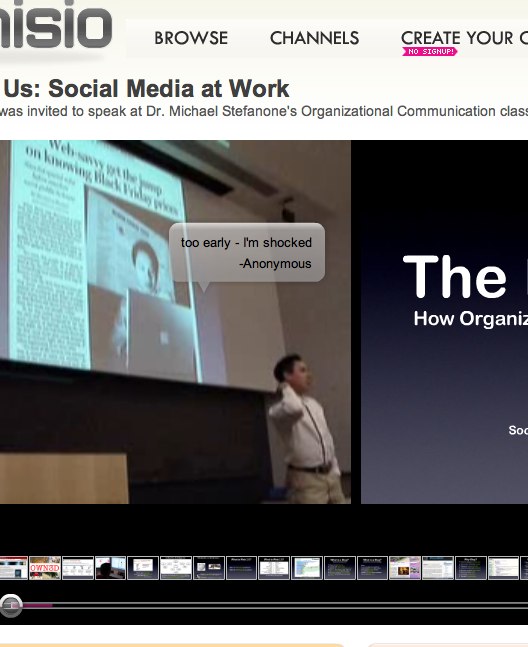This week's big news that the <a href="http://www.computerworld.com/action/article.do?command=viewArticleBasic&articleId=9111221">YouTube folks at Google acquired Omnisio</a> is a pleasant reminder that there's plenty of room for innovation in the Net video space. <i>InformationWeek</i>'s parent company TechWeb runs a lot of events (Web 2.0, Interop, Enterprise 2.0, etc.) and when we first heard of the Omnisio buy, we gave it a look-see given two very event-relevant features: First, the ability

This week's big news that the YouTube folks at Google acquired Omnisio is a pleasant reminder that there's plenty of room for innovation in the Net video space. InformationWeek's parent company TechWeb runs a lot of events (Web 2.0, Interop, Enterprise 2.0, etc.) and when we first heard of the Omnisio buy, we gave it a look-see given two very event-relevant features: First, the ability to integrate slide shows with video. Second, the way a community (e.g., event attendees watching a presentation) can drop comments into talk-bubbles at any time and virtually anywhere in the user interface. After my colleague Alex Dunne started an internal Omnisio thread, I responded with this mini-review:For those that haven't had a chance to look yet, Omnisio is sort of like Twitter or IRC meets Internet Video+PowerPoint with a dash of TiVo tossed in.
At its core, Ominisio offers video of a presenter that can be synchronized with the presenter's slide show (there are two equal-sized panes...video on the left, slide show on the right). Today, when a bunch of Twitterers are sitting in on a presentation at technology events, they often tweet about what they're seeing with some very candid thoughts. Their tweets show up on Twitter.com (and wherever else those tweets are piped, usually via RSS).
Omnisio doesn't appear able to handle live Webcast videos yet. But as an event company, having Omnisio's functionality layered on top of a live or recorded session is exciting. That's because, if the presentations are Omnisio-enabled, instead of Twittering on Twitter where the feedback is completely divorced from the content, those same Twitterers could post their comments into Omnisio's translucent talk-bubbles that are superimposed directly on top of the user experience (the exact location within either pane is determined by where the user clicks -- see image below).
What's very cool about this is that Omnisio permanently makes a record of and embeds the comments in the video. So, the next person to play back a particular video/PowerPoint combination will see all of the comments that were made by previous viewers. Those comments will appear/disappear exactly as they did (and when they did) as when they were originally posted.
Additionally, all of the comments are listed below the player in a typical comment listing. But what makes the listing atypical is the sort order. Normally, the way most comment boards work, the most recent comment appears at the top or the bottom of the list. YouTube's comments work this way.
With Omnisio, the list is sorted according to where in the video's timeline it appeared, which means that the most recent comment gets inserted into the comment thread based on the video timecode that goes with it. According to Omnisio's FAQ, "Very soon, you will be able to restrict who can comment on your videos, but for now we want everyone to have a play around and familiarize themselves with the feature." Today, commenting is set on or off at the time of publishing into Omnisio.
Questions that come to mind (not answered by Omnisio's online FAQ): Can it be moderated? Not that Twitter can, but it's a fair question for people like event producers looking to draw community into their content. I've seen some Omnisio-hosted videos where the user interface is so cluttered with talk-bubbles that you can'y see the content underneath it.
Can it be integrated with other infrastructures? For example, can all of the comments be piped into Twitter and vice versa? My sense on this question is that the answer will be no because Google isn't going to want to support Twitter (Twitter is a competitor to Google's Jaiku). On the other hand, maybe yes because, well, Google theoretically never does anything evil. But this would be cool to have comments somehow auto-posted so end-users (the community) can select the comment-publishing infrastructure of their choice.
Also, can the comments be RSS-enabled (as far as I can tell, they're not now)? To the extent that this is sort of like TiVo, you know that comments are going to continue to file in for, like, ever. Some people (including video publishers) may want to monitor that ongoing community activity without having to return to the video itself.
Via e-mail, I popped some of these questions to Omnisio co-founder Ryan Junee. His response?
The features you list were all things we had thought about doing. We are still figuring out the plans going forward, but there's a chance features like these will appear in some form or another.
Here's the screenshot:

About the Author(s)
You May Also Like





